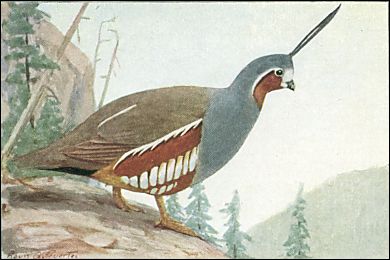

As the climate of the Southwest changes through time, plants and animals enter and leave the area, each according to its ability to survive under the environmental conditions. In many cases, we might consider the exchanges as fair trades. Some cases, though, we might well mourn.
Most Chihuahuan Desert inhabitants would despair if we lost of any of our three native quail. These same people would be equally saddened if they knew of the disappearance of another that is equally spectacular. Limited today to a geographic range running from the West Coast inland to Idaho and Nevada, the Mountain Quail has been identified in Ice Age deposits in the foothills of the Guadalupe Mountains.
We have no way of directly judging how common this bird was in our area, but historic accounts from Oregon indicate numbers in the 1880s great enough to bring trapped birds to market, 20 or more to a crate, to be sold at $3 per dozen.
If these birds had survived, would we have been smart enough to have
not done the same?

![]()
Contributor: Arthur H. Harris, Laboratory for Environmental Biology, Centennial Museum, University of Texas at El Paso.
Desert Diary is a joint production of the Centennial Museum and KTEP
National Public Radio at the University of Texas at El Paso. ![]()

Painting of Mountain Quail by Louis A. Fuertes. From Henshaw, 1921.
Brodkorb, P. 1964. Catalogue of fossil birds: Part 2 (Anseriformes through Galliformes). Bulletin of the Florida State Museum, Biological Sciences, 8 (3):195-335.
Henshaw, H. W. 1921. The book of birds. Common birds of town and country and American game birds. National Geographic Society, 195 pp.